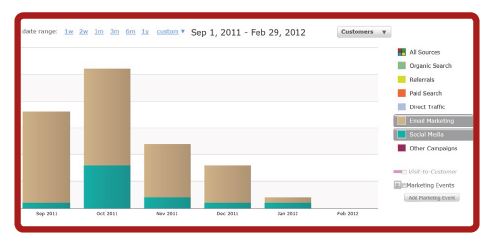Innovative marketing how-to: Make great blog content
6 Steps to creating great blog content Now that you know the business value of blogging, it’s time to delve into the how. Are you wondering what...
5 min read
Mark Parent
November 10, 2016 9:44:27 AM EST

Kevin McGrath has spent the past 10 years helping businesses of all shapes and sizes improve their online presence.
As the CEO of Beacon, his goal is to help make life just a little bit easier for marketers and small business owners everywhere.
We recently chatted with Kevin about lead magnets, downloadable content, and how they can both help increase conversions.
 Capturing an email address is an important starting point
Capturing an email address is an important starting point
in the inbound marketing lifecycle. ![]()
For any small business, the capture of an email address is an incredibly important stage at the beginning of the inbound marketing lifecycle. But many businesses are missing opportunities to fill the top of their funnel.
While downloadable incentives like eBooks have proved to be an effective way of boosting conversion rates on opt-in forms, it is a tactic that has been out of reach for cash-strapped small businesses. The process of hiring and working with a designer can take several weeks and cost thousands of dollars.
Beacon gives small businesses the opportunity to create professionally-designed resources like eBooks in as little as 90 seconds for no cost whatsoever. Our goal is to help more small businesses generate as many leads as they can without breaking the bank.
There are so many different types of lead magnets that you can use; choosing the right one can be tricky. From eBooks to online courses, podcasts, and even discount codes, the list is endless.
In our experience, the content offers that work best are the ones that teach the reader something they didn't already know. This could be a simple how-to guide or a comprehensive eBook, but if you can teach your audience something that will help them to improve their business, then they will forever think of you as an expert in your industry. When it's time to purchase a product or service, you will have a head start on your competitors because the prospect already trusts you. That's the magic of inbound!
The biggest mistake that we see when it comes to downloadable content is when companies create a single, generic content offering aimed at every potential visitor to their website. This is usually an eBook that appears in the sidebar of every page on the company blog - even if the eBook is not relevant to that particular post.
We like to think of individual blog posts as mini landing pages. That means that each blog post could and should contain an opt-in opportunity that is unique to that particular post. For example, if your blog post is titled "How to make sure your blog posts rank in Google," then you could include a content offer like a checklist that would help people to implement the advice in the blog post. The checklist could be titled "The Ultimate SEO Checklist - Everything You Should Do Before Clicking Publish."
Because this lead magnet is so relevant to the blog post, a reader is much more likely to opt in. This technique always brings higher conversion rates than if you had used a generic lead magnet that tries to appeal to everyone.
If a company has an established blog and finds themselves in need of more leads, then the fastest way to do that is to recycle content that they already have.
In this situation, the first thing you need to do is go to Google Analytics. You want to set a nice long date range - perhaps the past 12 months or more if your blog has been around for a while. Next, sort that content in order of page views from highest to lowest. By doing this, you are able to find your evergreen blog content; i.e., the posts that have performed consistently well over a long period of time. The great thing about evergreen content is that it has already been proven to be successful; your audience has voted for it with every page view.
Next, you should look for approximately five articles in a related category that you can combine into an eBook. Five blog posts will equate to about 30 pages in a PDF depending on their length. The goal is for people to actually read the book when it has been downloaded, so you don't want to make it too long.
Once you have picked the content to include, you can use a tool like Beacon to automatically convert these blog posts into a professionally-designed eBook. The whole process should take just a couple of minutes.
Finally, you should create five different calls to action - one for each blog post contained in the eBook. Then offer the eBook on each individual post. Since you already know that these pages attract visitors from your Google Analytics research, you'll be able to convert these visitors into leads in no time.
 The content offers that work the best are the ones that teach
The content offers that work the best are the ones that teach
readers something they don't already know. ![]()
No! This is the trap that many marketers fall into. When planning a lead magnet, it's natural to think big and try to create the most original, mind-blowing piece of content that has ever existed. The problem with this type of content it that it takes a long time to produce, so most marketers will start but never finish it.
Instead, we would recommend that people start small and go for the quick win, particularly if they are new to the lead magnet tactic. Find the single blog post in your archive that is already performing well in terms of page views, and think about how you could add more value to it. Bundle this additional content with the original post and offer it as a bonus download. This is a great way of rewarding the people who decided to opt in.
The biggest result that marketers will see from using lead magnets is increased conversion rates. Because lead magnets are an incentive-driven call to action, conversion rates are always higher than a generic "sign up for my mailing list" CTA.
When a company's leads start to plateau, they automatically think that they need to increase traffic to their site in order to fill their funnel. This usually means an increased ad spend. Alternatively, if they focus on the conversion rate of their opt-in forms, they will see a much bigger lift in terms of the quantity of leads generated in a shorter space of time - and without the added cost of paid traffic.
Some bloggers like Brian Dean from Backlinko have reported increases of 529% in their conversion rates once they started using lead magnets. In terms of leads, this would bring the same results as increasing traffic by 529%. I know which approach seems easier to me!
One of the secondary signals around lead magnet success is social shares. If people are finding your content so valuable that they are willing to share it with their peers, then you're on to a winner.
In order to capitalize on this, we would recommend that people include the social sharing mechanism within the eBook itself. This means that you have a little bit more control over how people are brought to your resource so you can capture their lead information as well.
I think we're at a very early stage with lead magnets. We're quite excited about the opportunity to analyze how lead magnets are consumed. Do they perform their secondary task of nurturing a lead? What content within the magnet was most popular? Did people read it at all? What did they read after they finished it? This is something that is commonplace with web analytics nowadays, but there seems to be a bit of a blind spot when it comes to downloadable content.
Get your free copy of our Content Marketing for Marketers eBook for additional guidance on creating and shaping your content to meet the needs of your audience.

Make sure to connect with us on LinkedIn to get valuable insight on the latest news in marketing and website design. Follow us here:

6 Steps to creating great blog content Now that you know the business value of blogging, it’s time to delve into the how. Are you wondering what...

1 min read
When the time comes to redesign a website – and as marketing consultants will often tell you, that time usually comes around once every one and a...

“Closed-loop marketing enables us to do better marketing.” In Chapter 3 of the new Ebook “An Introduction To Closed-Loop Marketing”, SugarBush...